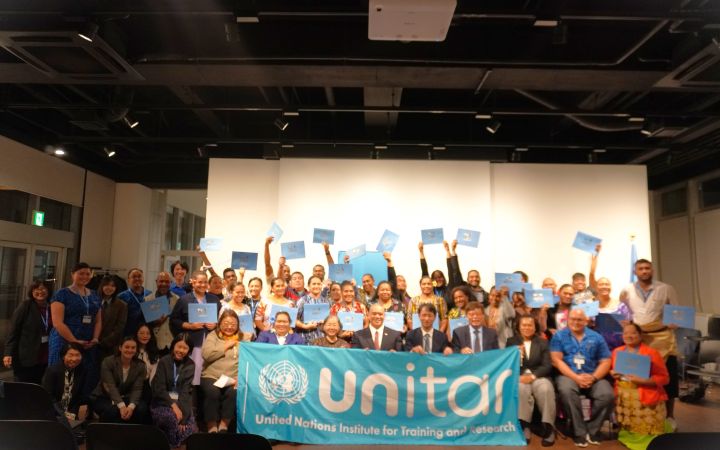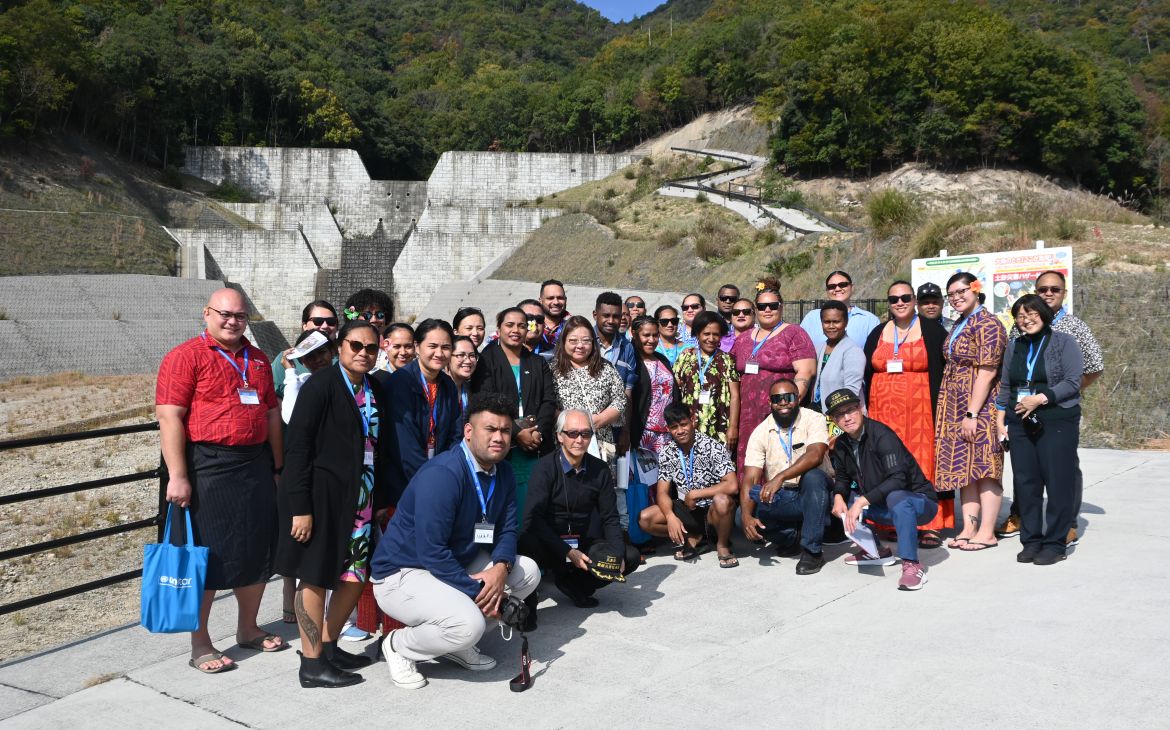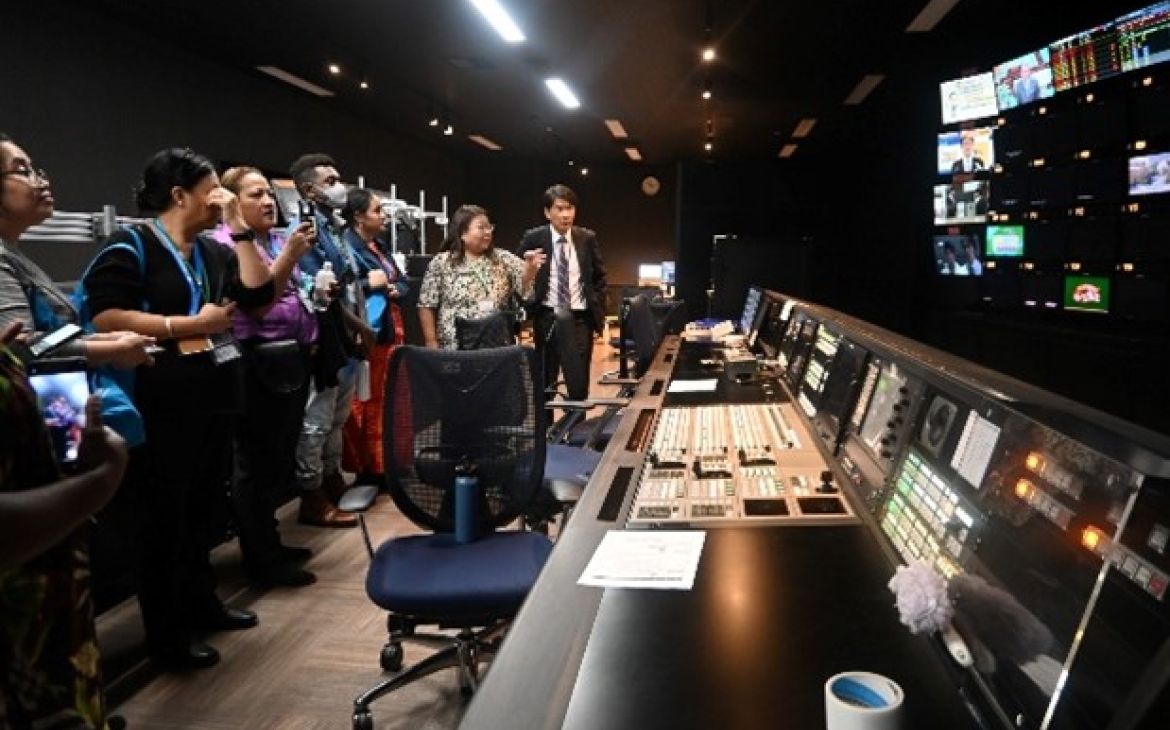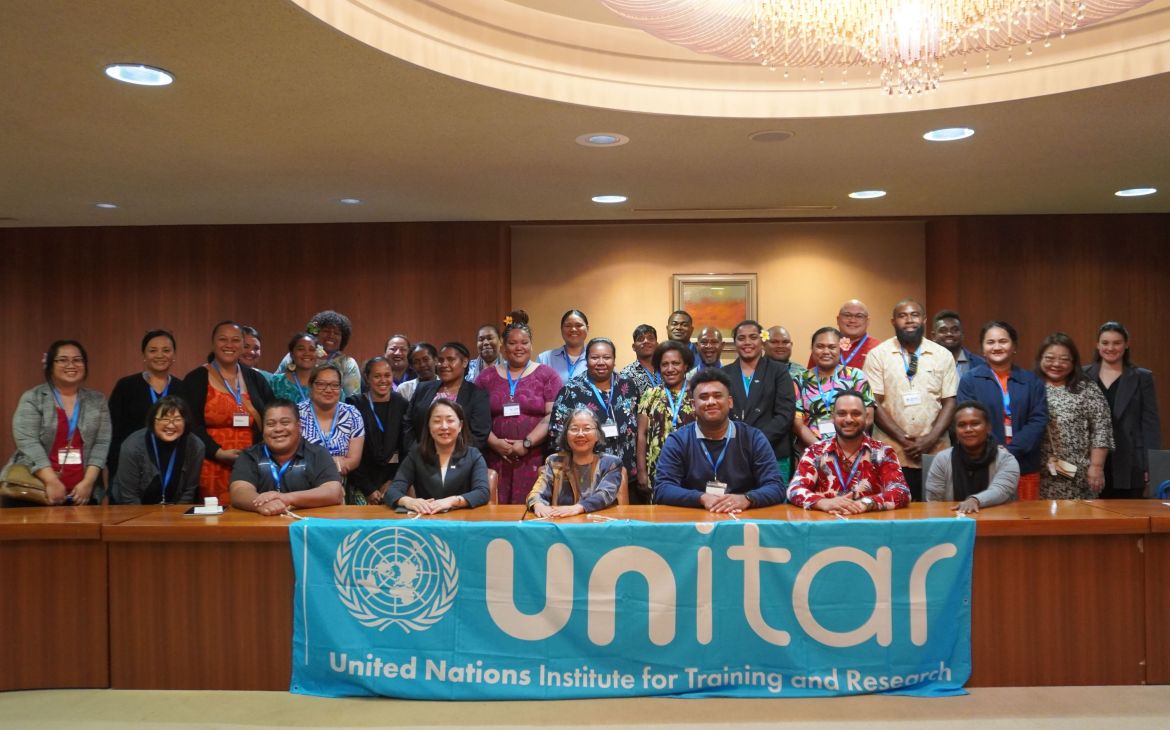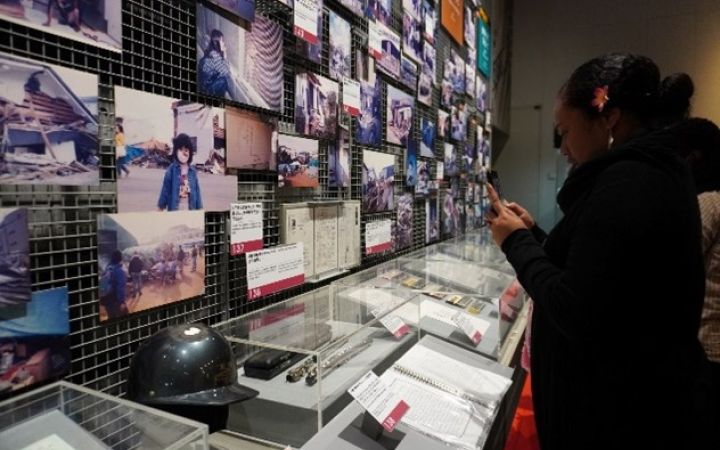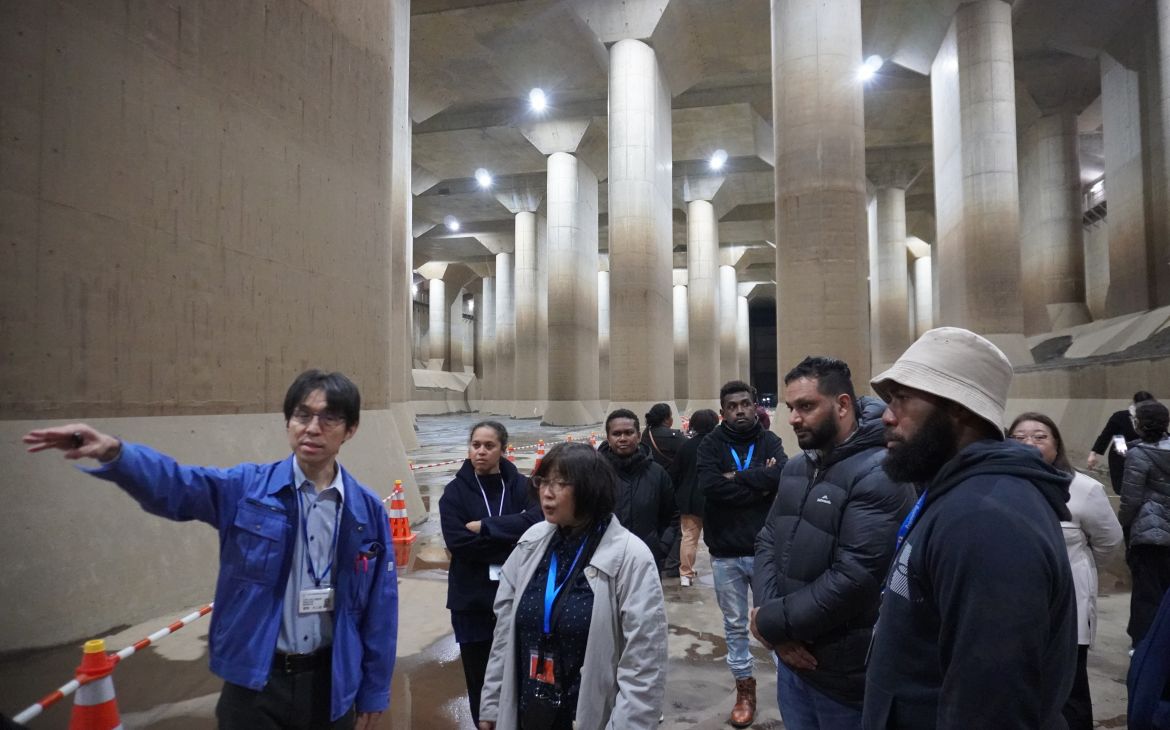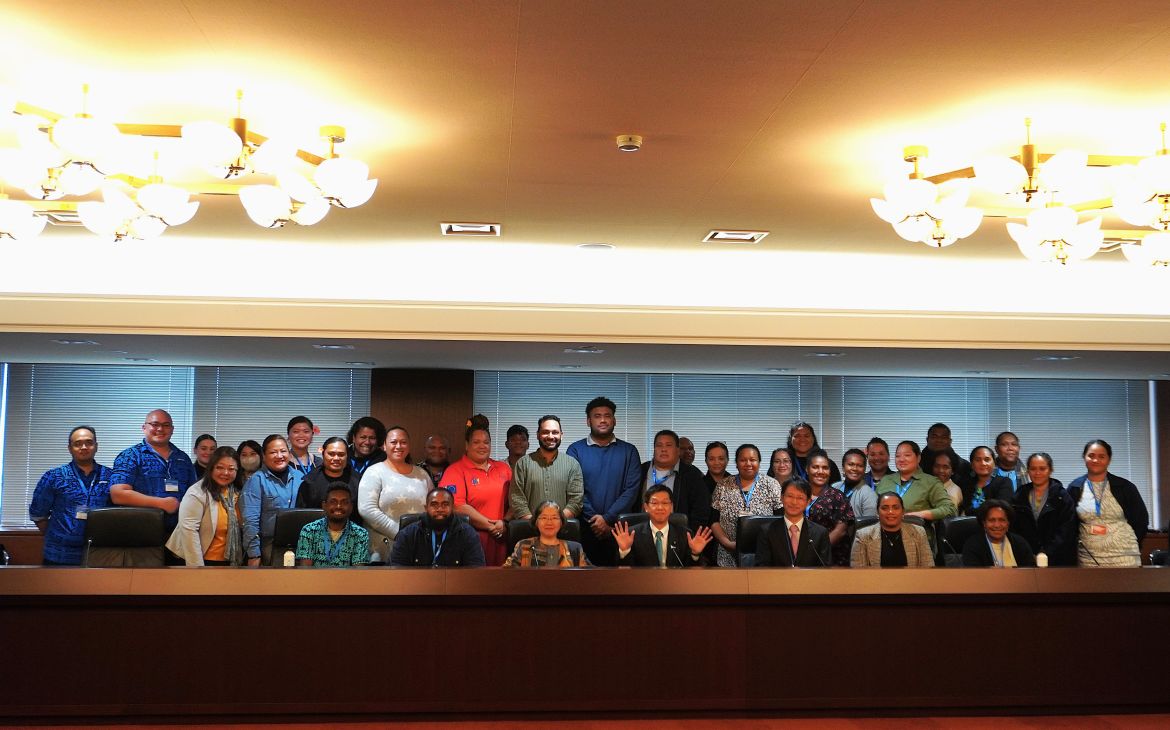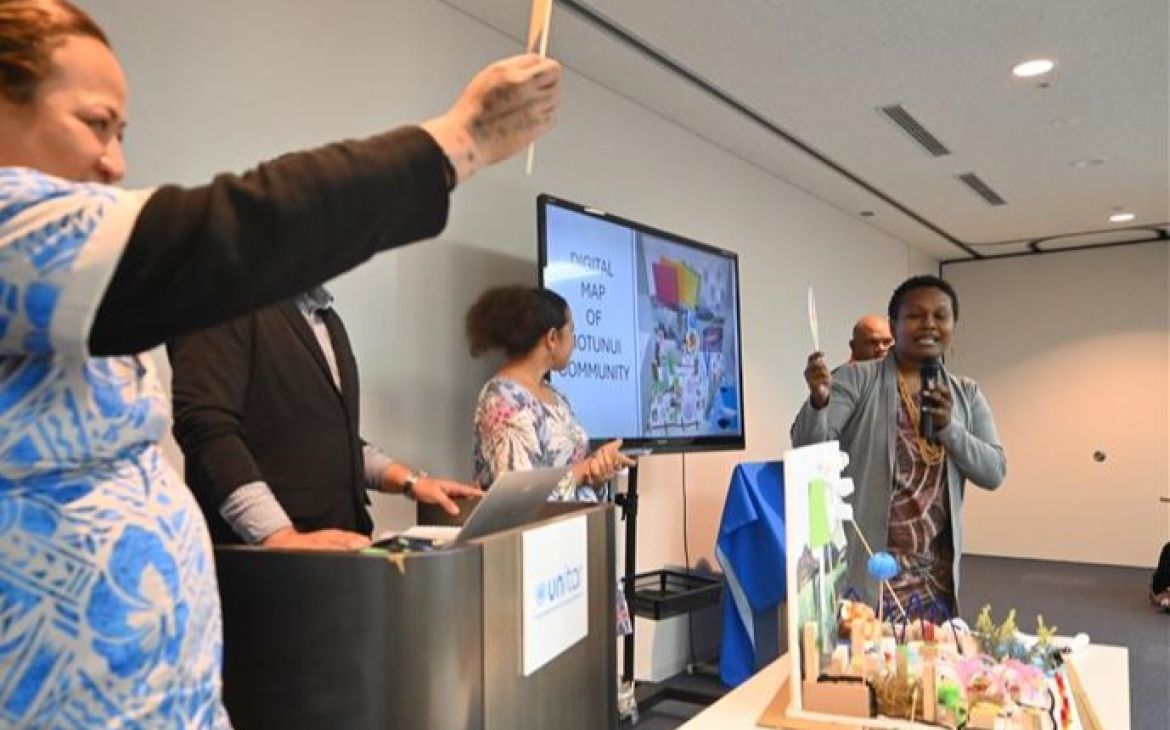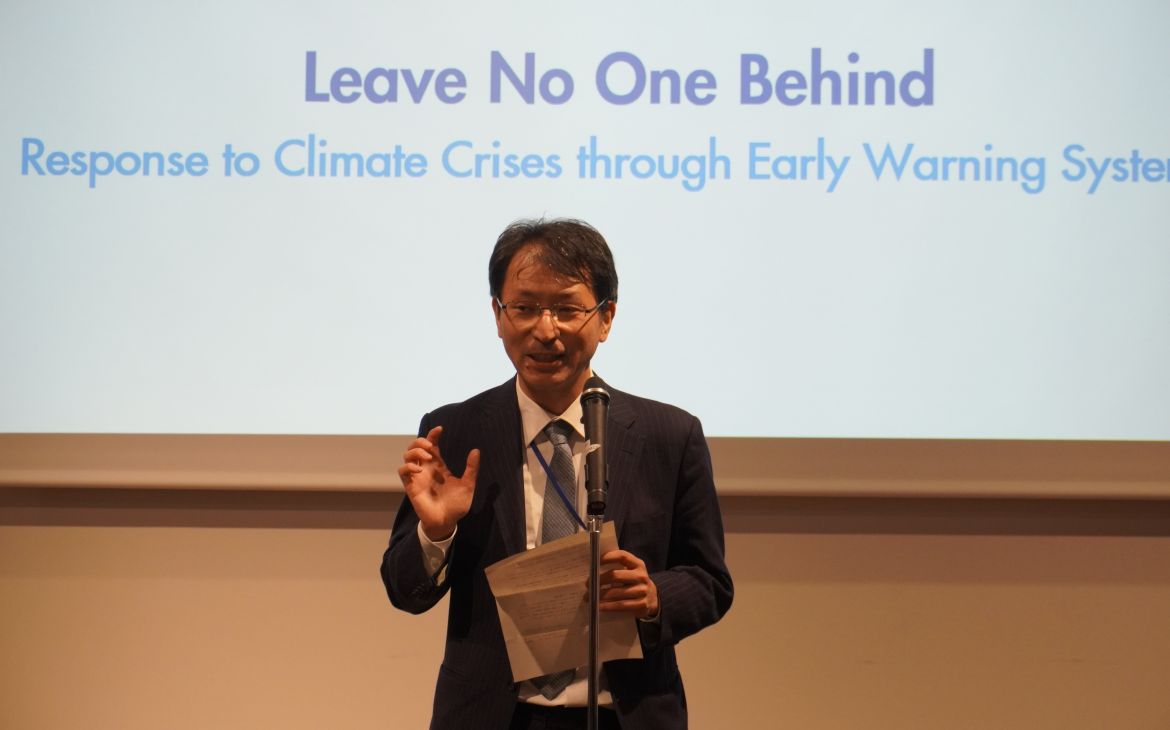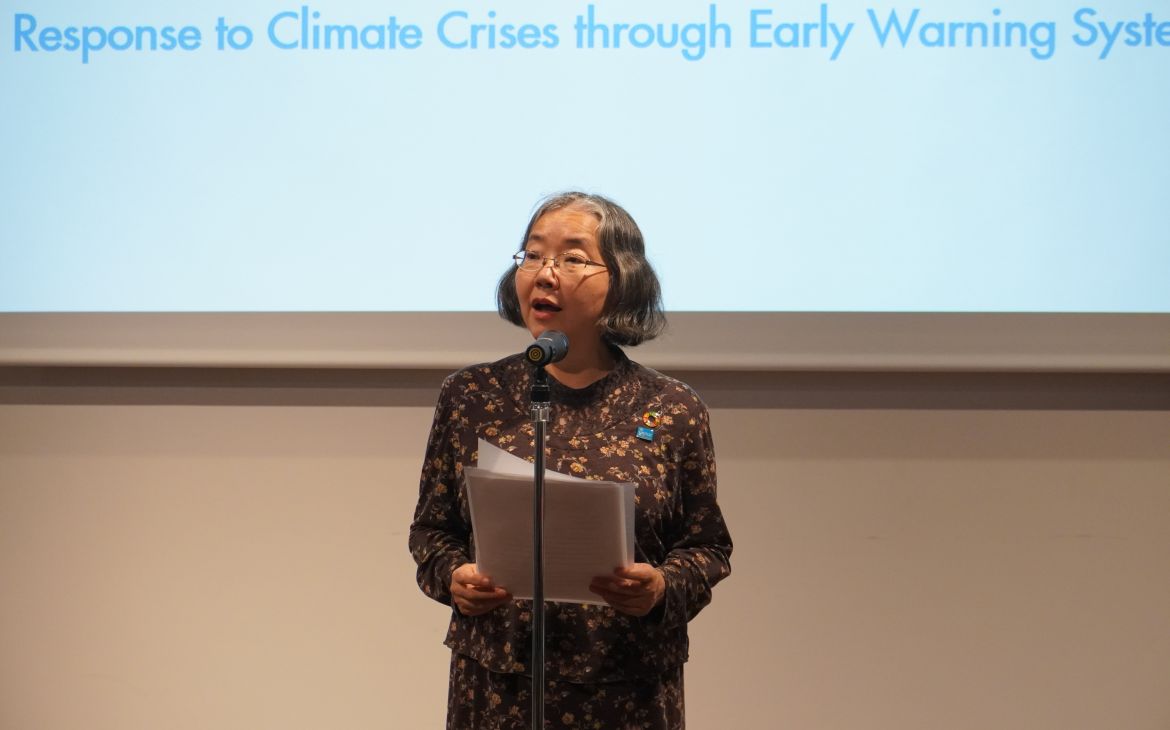- On 22 November, 29 changemakers from 11 Pacific small island countries completed the second phase of the UNITAR “Leave No One Behind: Rapid Response to Climate Crises through Early Warning Systems” programme, which brought them to Japan to learn about early warning system tools and approaches to reduce disaster risks.
- During the study tour, the participants visited Hiroshima, Kyoto, Kobe, and the Greater Tokyo Area and engaged in interactive expert lectures and study visits, during which they learned firsthand about the practices, technologies, and research for effective early warning systems in Japan.
- The participants presented the project plans they had developed over the 12-day training to contribute to disaster risk reduction in their respective countries. At the closing ceremony, the participants received the certificates of completion for the Phase 2 training.
22 November 2024, Hiroshima, Japan – On 22 November 2024, 29 changemakers from 11 Pacific small island countries completed the second phase of the UNITAR “Leave No One Behind: Rapid Response to Climate Crises through Early Warning Systems” programme, which brought them to Japan to learn about early warning system tools and approaches to reduce disaster risks. The programme is financially supported by the Government and People of Japan.
As the culmination of their learning journey, participants presented the project plans they had developed over the 12-day training. The plans incorporate what participants saw and learned in Japan and are to be implemented to reduce disaster risks in their respective countries, with the ultimate goal of fostering resilience and reducing the impact of disasters in the Pacific.
In Japan, the participants went on field visits to Hiroshima, Kyoto, Kobe and the Greater Tokyo Area and engaged in interactive lectures led by specialists, through which they learned about early warning systems, effective collaboration and timely communication.
Hiroshima Sessions
The Pacific learners began their studies on 11 November 2024 in Hiroshima, with a lecture at Hiroshima University on the effect of climate change in the form of tropical cyclones.
They visited the Hiroshima City Torrential Rain Disaster Memorial Center, which was built to pass on what happened during and after the torrential rains in 2014 with the hope that the suffering would never happen again. There, they heard from a survivor, the director of the Memorial Center, about the experience and the community’s recovery efforts and preparedness for future disasters.
Hearing testimonies from disaster victims in Japan is quite an emotional journey, they are so effective at sharing the horror from the disasters that they have experienced in the past and learning from how they now apply to predict their lives and future generation is really moving and inspiring.” - Rebecca Tavioni (Cook Islands)
The key takeaway that I learned is storytelling. Storytelling can be a powerful tool in the Melanesian context. We learned how ancestors kept their histories and records in written documents and passed their messages on to the young generation through storytelling. I learned a lot about skills and knowledge to take this approach back to my country.” - Mathew Kuraiwae, training participant (Papua New Guinea)
At the Hiroshima Television Corporation, the group deepened their understanding of the media’s role in monitoring and disseminating early signals to protect people’s lives, in line with the disaster risk reduction and communication efforts led by the government of Japan.
The participants also joined lectures by Hiroshima Prefecture which introduced the local disaster risk situations and activities for disaster preparedness, by Hiroshima NPO Center on inclusive dissemination of disaster risk information amid extreme weather events and by Hiroshima City on the development of mobile phone applications to inform citizens of disaster risks in a timely manner.
I see the Japanese approach to early warning system is very proactive. It’s really focused on disaster preparedness. Some examples that we can see from the Hiroshima Prefecture Office are that they have a very practical way in terms of preparing the populations for different types of hazards and disasters. Raising awareness and community engagement are big things, and I really like that emphasis.” - Rachel Nunn, training participant (Samoa)
On 12 November, the participants paid a courtesy visit to Hiroshima Prefecture Vice Governor Ms. Yuko Tamai where they shared their learnings on peace and recovery of Hiroshima. Ms. Tamai welcomed the participants and expressed hope that their Japan study tour, which started from Hiroshima, will continue to be fulfilling.
KYOTO AND KOBE SESSIONS
In Kyoto, they joined a series of lectures at the Kyoto University Disaster Prevention Research Institute. The lecture topics ranged from community-based early warning systems for disaster prevention to Kyoto Prefecture’s mechanisms to protect cultural heritage from hazards. On the next day, they also learned about Kyoto City’s preventive measures against disasters, presented by the Kyoto City Office and a researcher at the National Research Institute of Fire and Disaster.
They then ventured to Kobe to learn at the Disaster Reduction and Human Renovation Institution the lessons from the Great Hanshin-Awaji Earthquake of 1995. There, they had a chance to hear firsthand accounts about the devastating earthquake that killed more than 6,400 people.
Even though it’s a very sad situation that Japan underwent, I draw strength from their resilience and using stories to empower the communities as a lesson, and that is something that I feel that is lacking in the Pacific. We tend to shy away from sharing negative stories, but the negative stories are things that we can look to and draw aspiration from.” - Mere Vukialau, training participant (Fiji)
SESSIONS IN GREATER TOKYO
The study tour then moved to the Greater Tokyo Area. At the University of Tokyo, the group heard about practical experiences with international frameworks for disaster risk management from the World Bank as well as with the Global Hydrological Prediction Center at the University of Tokyo.
At Japan Aerospace Exploration Agency (JAXA) Tsukuba Space Center, the participants learned about JAXA’s initiative on space-based international cooperation for disaster management in the Asia-Pacific region with the use of satellite technologies for earth observation and data collection.
The group also attended lectures at Waseda University on the case studies on tsunami disaster responses and coastal engineering for coastal disaster risk reduction. The participants also visited the Japan Meteorological Agency and learned about the agency’s vital role as a key institution for issuing countrywide early warnings.
They use science and marry it with traditional knowledge to strengthen technologies. Through the science and research component of it, they also partner with local communities to influence decision-makers and to convince the leaders that this is based on the research.” - Peni Seru, training participant (Fiji)
The group also saw practical applications of disaster risk reduction. Guided by a researcher from the University of Tokyo, the participants toured the Kashiwanoha Smart City in Chiba Prefecture and gained insights on disaster resilient, climate-smart and inclusive urban development. At the Koto and Edogawa Area in Tokyo, they learned about coastal engineering solutions to protect the communities against flooding and sea-level rise. And the participants saw the Metropolitan Area Outer Underground Discharge Channel in Kasukabe City, Saitama Prefecture, one of the world’s largest water discharge facilities, and learned firsthand how Japan protects the vast population of the Tokyo Metropolitan Area from flooding with cutting-edge infrastructure.
On 21 November, the participants paid a courtesy visit to H.E. Mr. MATSUMOTO Hisashi, Parliamentary Vice-Minister for Foreign Affairs. The participant representatives shared their valuable learning experiences from the Japan study tour and the group received words of encouragement from H.E. Mr. MATSUMOTO, who expressed his hope for them to play an active role in the field of disaster prevention.
FINAL OUTCOME AND WAY FORWARD
On 22 November, the final day of the training in Japan, the participants presented in groups their consolidated learnings from the trip and how they might apply what they learned to design early warning systems that are appropriate for their countries and region.
The closing ceremony to recognize the completion for the programme’s second phase was also held on the same day, at the United Nations University. The ceremony welcomed the following guests of honour:
- Mr. ANDO Shigemi, Director, Global Issues Cooperation Division, Ministry of Foreign Affairs
- Dr. T. Suka Mangisi, Ambassador Extraordinary and Plenipotentiary, Embassy of the Kingdom of Tonga in Japan
- Ms. Helen Tanuvasa Chou-Lee, Counsellor/Deputy Head of Mission, Embassy of the Independent State of Samoa in Japan
- Ms. Karalaini Belo Saina, Second Secretary, Embassy of the Republic of Fiji in Japan
In her closing speech, Chisa Mikami, Head of UNITAR Hiroshima Office, congratulated the participants and recognized their continued efforts in seeking knowledge and skills on early warning systems. She encouraged them to translate the lessons learned from the programme into tangible actions to protect lives from disasters and enhance disaster resilience back in their communities.
As you prepare to return to your communities, remember that the impact of your work extends far beyond the programme. Early warning systems and rapid response initiatives are powerful tools for protecting lives, reducing harm and fostering resilience. You now carry with you advanced strategies, a deeper understanding of disaster risk reduction, and a network of like-minded peers and experts to support you in your mission.” - Chisa Mikami, Head of UNITAR Hiroshima Office
Mr. ANDO Shigemi presented the certificates of completion to participants, recognizing their achievements from the programme’s second phase.
UNITAR would like to express heartfelt gratitude for the invaluable support from the Government and People of Japan. We would also like to acknowledge all the resource persons, institutes and organizations who generously shared their time and expertise with the participants.
ABOUT THE “LEAVE NO ONE BEHIND: RAPID RESPONSE TO CLIMATE CRISES THROUGH EARLY WARNING SYSTEMS” TRAINING PROGRAMME
The UNITAR “Leave No One Behind: Rapid Response to Climate Crises through Early Warning Systems” training programme aims to equip individuals and communities in Pacific Island countries with the knowledge and skills to effectively disseminate, monitor, analyse and respond to early warning signals for climate hazards and extreme weather events. Ultimately, the programme will help save lives and reduce the negative social and economic impact of climate-related hazards.
In the first phase of programme, over 200 officials and professionals from 16 Pacific Island countries embarked on asynchronous online learning and explored risk management, tools, knowledge and technologies related to early warning systems through a series of expert-led webinars and lessons on an online learning platform.
The top performers from the first phase were selected to join the second phase in Japan.
The programme is part of the UNITAR Shimanami Collective initiative, which comprises a series of training programmes to build resilience against disasters and enhance sea and human security in the Asia-Pacific, with a particular focus on empowering youth and women. Financially supported by the Government and the People of Japan, the Shimanami Collective initiative consists of specialized training in three areas: sea and human security, early warning systems and women’s leadership in disaster risk reduction.
about unitar
The United Nations Institute for Training and Research (UNITAR) is a dedicated training arm of the United Nations. In 2023, UNITAR trained over 540,000 learners around the world to support their actions for a better future. UNITAR has a global presence, with offices in Geneva, Hiroshima, New York and Bonn and networks around the world. Find out more at www.unitar.org


